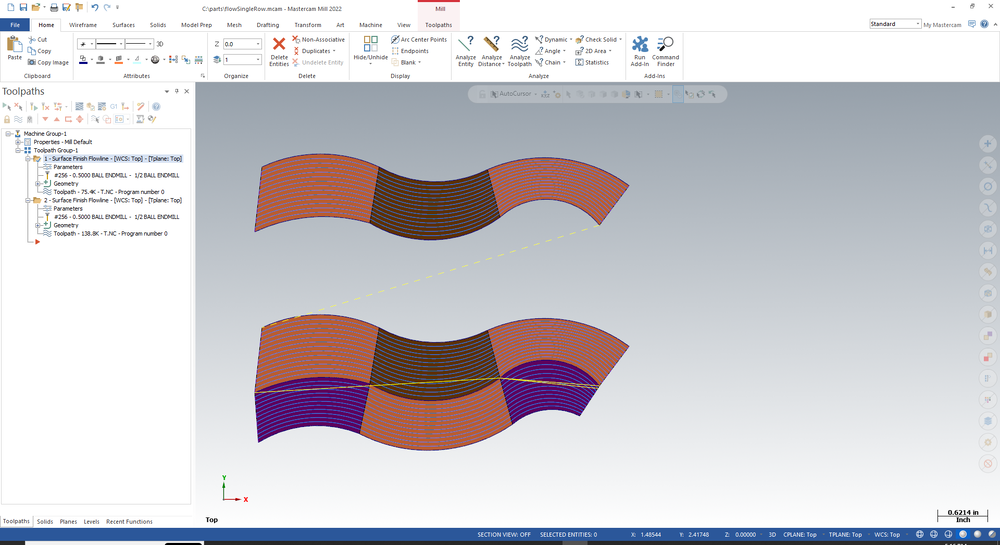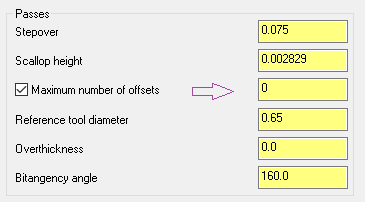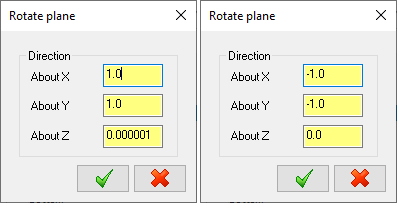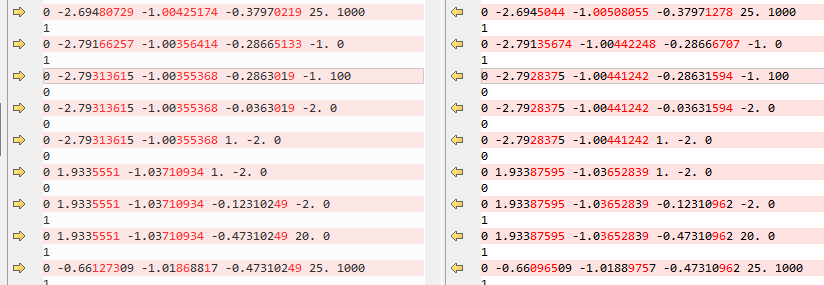
billb
CNC Software-
Posts
92 -
Joined
-
Last visited
-
Days Won
1
Content Type
Profiles
Forums
Downloads
Store
eMastercam Wiki
Blogs
Gallery
Events
Everything posted by billb
-
2D High Speed (2D Area Rest Mill) is bugged and not repeatable
billb replied to SlaveCam's topic in Industrial Forum
Yes, please, send an example to [email protected]. Thank you. I don't think this is a known issue (at least, I don't recall seeing this). -
Hi, when you have a chance and if you are able, would you please email us your part? Send it to [email protected]. I created my own MC2023 Mill test part and it works (one other op before or after). Perhaps there is a specific parameter setting that is causing trouble. Thank you.
-
If you have a slow finish/contour toolpath, please send it in and we will have a look. We recently discovered a regression with bull nose tools (now repaired).
-
Disregard my response. Rekd’s answer is correct - see stock on floors and walls in Model Geometry. Those may default to a nonzero amount.
-
Yes, check the stock to leave amount. In this classic surface toolpath, the drive stock to leave is found on the second tab page. Also, check the tool tip/center option also found on the second tab page. Maybe it is set to “center”.
-
When flowline was first released, it only handled a single surface. Then was added the ability to handle multiple drive surfaces by flowing along a row of surfaces (crossing over one shared edge between two consecutive surfaces). Later, was added the ability to handle a wider set of connected drive surfaces such as multiple rows or a grid or a quilt. The "single row only" allows you to revert back to the first algorithm, should that do a better job (on a single row) than the latest quilt or grid approach. The top toolpath is a single row (using the single row option). The bottom toolpath is a grid or quilt with "single row" unchecked.
-
Yes, please send it in. We may be able to provide insight. When it regenerates quickly, I suspect that it is able to reuse cached data. When opening the file the first time, maybe there is no data cached (or it is not reused).
-
Trim toolpath not working in 4x cor setup w/ contour multi-pass
billb replied to SlaveCam's topic in Industrial Forum
Got it! Logged as R-32276. -
problem with 3d milling on a multiaxis tutorial
billb replied to aaron tabor's topic in Industrial Forum
It looks like the containment boundary is defined in the front view. Change your CPlane and TPlane both to Front and regen. Now look from the front view and you will see that you machine everything outside the "D" shaped containment boundary. That is because you have enabled the option to include the silhouette. Using a silhouette boundary AND a containment boundary gives you a checkerboard effect (in, out, ...). Uncheck the include silhouette option and regen and you will see that you machine everything inside the "D". As filed, in the Top view, you are machining everything in the silhouette boundary and the containment boundary looks like a straight line in Top view and is (quietly) ignored.- 1 reply
-
- 1
-

-
Surfaces and Model both selected on 3D toolpath
billb replied to rickyrayjay's topic in Industrial Forum
What happens when you create surfaces from that solid? Do they hold their shape? What happens if you use HST/Raster with the same geometry (solid and surfaces)? If you duplicate the issue, please send it to [email protected]. Thanks. -
Classic surface rough/pocket supports undercutting. I was just able to use zigzag pocket method (with finish pass off) to get cutting motion a little bit like rough/parallel. I used the gap settings to order the cuts from the bottom to the top. I used an entry point. (Alternative - turn off roughing passes, turn on finish passes with nonzero spacing and more than one pass.) Rough/parallel does not support undercutting.
-
Looks like the raw flowlines are painted in the hard-coded color "DK_GRAY". I entered S-87089 to see if we can improve this (allow the color to be user-determined). Thank you for reporting this.
-
It is the Tolerance! Your Resolution is ignored if it is less than your Tolerance. (I didn't know this until I looked with the debugger...) The processing code reverts back to 1.25mm resolution. I have submitted this as D-45483. As a work-around, set your Tolerance to just less than your 0.01 Resolution (I used 0.009). You will notice that the processing takes longer. The answer I got was 87.01775. Thank you for reporting this.
-
Hi, I looked at the dialog code - it looks like the minimum segment length is set to 3X the total tolerance on the way into the dialog. So, you may have found the work-around - set the total tolerance really small, set your segment length, exit the dialog, reenter the dialog and set your total tolerance back to the larger value (this time, don't touch the segment length). As you exit, you may get some warnings but it seems like the smaller segment length will stick (and get applied to the toolpath). I logged this as D-45365 so that we may take a closer look. The tolerances and settings all do work together - you may have a valid use case for a segment length smaller than the total tolerance - so, I think, the dialog should allow that. But maybe a warning would still be helpful(?). Thanks for reporting this.
-
You may have asked before - search for D-41194 no ... D-41195 (sorry)
-
Back to 3D HST Pencil - set your maximum number of offsets to zero. That will give you the pencil crease and no side offsets.
-
In X7 thru MC2017, it is possible to select check/avoidance geometry in HST-Scallop but a warning message is issued indicating it would be treated as drive/machining geometry (with the drive stock to leave applied). In later releases in the 3D HST VS2L (Variable Stock To Leave) dialogs, it is a bit harder to select avoidance geometry in HST-Scallop. By twists and turns (such as changing style to Raster, making avoidance selection and changing back to Scallop) you can get avoidance geometry selected but the processing rule still applies - for Scallop, it will be treated as machining geometry. So Equal Scallop is the way to go - it allows avoidance geometry. Classic surface finish/scallop was the first Mastercam toolpath with a 3D stepover over an arbitrary set of geometry. It worked pretty well but small features could introduce noise in the resulting path (not as smooth as one might desire). HST-Scallop was the second 3D stepover. It also worked pretty well (offering the 3D HST lead and linking features) but could chamfer sharp corners in the offset passes. HST Equal Scallop is the third 3D stepover (you could say third generation). It works carefully to produce crisp equidistant offset passes over arbitrary geometry. It also offers a spiral option. Please try HST-Equal Scallop - it should meet your needs. If not or if you notice that HST-Scallop or finish/scallop yields a better path, please send us a sample. Thank you!
-
Yes, not all HST path styles support avoidance geometry. In this case, try "Equal scallop" rather than "Scallop". Equal scallop supports avoidance geometry and offers several other benefits beyond Scallop.
-
32Gb this one, 16Gb the other one. You are right, I'll retest with smaller amounts. Memory buffering did play a significant role in one algorithm early on but it was re-engineered for better memory management (somewhere between V9 and X9). The Memory buffering setting does still come into play in finish/contour, rough/pocket, rough/restmill and even some Multiaxis situations.
-
I happened to be looking at Memory Buffering recently. It is used in a few processing situations but it doesn't have as much of an impact as it once did (many releases ago). I changed it to 1% and 100% and got nearly the same toolpath calculation times. I'm considering removing it unless I find a situation in which it really helps.
-
Can you use 3D HST Dynamic OptiRough? In MC2021, there is a new OptiRough parameter to allow you to skip pockets - when cutting from the outside, you can skip all pockets. In OptiRough, this parameter is found on the Toolpath Control page. This parameter isn't available in 3D HST Area Roughing.
-
If possible, please send a file to [email protected]. We can take a closer look at your 3D HST issue. Thank you.
-
This is likely a case of R-22934 / D-41195. The issue is the handling of the custom WCS. The issue can happen in legacy surface toolpaths (finish/blend, finish/project, rough/project ...) but not in 3D HST. The issue has been corrected for Mc2021. For Mc2020, the best work-around is to rotate incrementally the WCS plane. Rotate it 5 degrees about Z, regenerate the path, rotate it -5 degrees about Z and regenerate the path a 2nd time. If this works, great. It doesn't always work. (I was unable to learn why it does / doesn't work.) The second best work-around is to rotate incrementally the WCS plane 0.000001 degree about Z and leave it rotated. To do this, you must rotate incrementally, twice, but you don't need to regenerate the path in between steps. Just apply these two incremental rotations: This does alter the WCS. The resulting path motion will be slightly different than what the original WCS would yield. I see differences of about 0.0003 in the tool positions. 61% of original size (was 824x285) - Click to enlarge
Join us!
eMastercam - your online source for all things Mastercam.
Together, we are the strongest Mastercam community on the web with over 56,000 members, and our online store offers a wide selection of training materials for all applications and skill levels.








